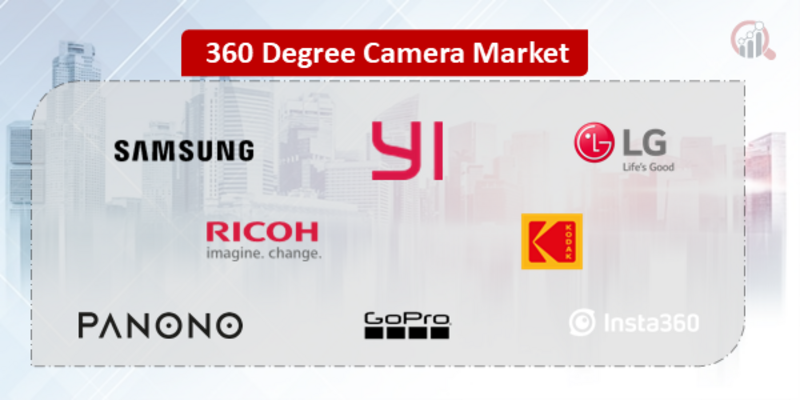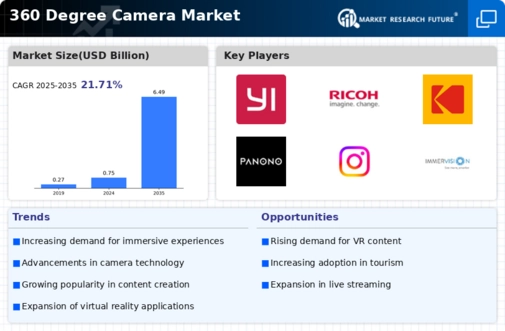Top Industry Leaders in the 360 Degree Camera Market

*Disclaimer: List of key companies in no particular order
Competitive Landscape of the 360-Degree Camera Market:
The 360-degree camera market is capturing the imagination and attention of consumers and businesses alike. With the ability to capture immersive, all-encompassing visuals, these cameras are finding applications in various sectors, from real estate and travel to education and entertainment. The competitive landscape is heating up, with established players and emerging startups vying for a slice of the pie.
Some of the 360 Degree Camera companies listed below:
- Samsung Electronics
- YI Technology
- LG Electronics
- Ricoh
- Kodak
- PANONO (Professional 360GmbH)
- GoPro
- Insta360
- Digital Domain Productions
- 360fly
Strategies adopted by key players:
- Innovation: The race is on to develop cutting-edge features like higher resolutions, improved stitching algorithms, and AI-powered editing tools.
- Specialization: Catering to specific niches, like action sports, underwater filming, or real estate tours, allows brands to stand out.
- Software and Ecosystem: Building robust editing software and integrating with VR platforms and social media creates a seamless user experience.
- Affordability: Making 360-degree technology accessible to a wider audience through competitive pricing is crucial for market expansion.
Factors Shaping Market Share Analysis:
- Product Portfolio: The breadth and depth of a company's product line play a crucial role. Players offering a range of cameras catering to different price points and functionalities attract a wider audience.
- Technology and Innovation: Continuous investment in research and development to improve image quality, stitching algorithms, and software features keeps companies ahead of the curve.
- Distribution Channels: Leveraging online and offline retail channels, partnerships with major electronics stores, and collaborations with social media platforms are crucial for brand visibility and market reach.
- Content Creation and Marketing: Engaging marketing campaigns that showcase the creative possibilities of 360-degree cameras and partnerships with content creators can drive user adoption and brand loyalty.
New and Emerging Trends:
- AI-powered features: Integration of AI for automatic stitching, horizon leveling, and content editing is enhancing user experience and making 360-degree cameras more accessible.
- Live streaming: The ability to live stream 360-degree content is opening up new avenues for virtual tours, events, and immersive experiences.
- Cloud storage and editing: Cloud-based solutions for storing and editing 360-degree footage are simplifying workflows and making collaboration easier.
- Vertical-specific applications: 360-degree cameras are finding specialized uses in fields like real estate, education, and healthcare, offering unique perspectives and enhancing engagement.
Latest Company Updates:
On Jul. 10, 2023, Uno Minda, a leading automotive solutions supplier, launched a new car infotainment system with a 360-degree camera, 9-inch android player, WTUNES-649TAACP, and 36-band equalizer in the Indian aftermarket. The company states that this car multimedia is powered by a T5 processor that supports wireless connectivity. The car infotainment system's key features include Android 11, 4 GB RAM, a 36-band equalizer, and a 360-degree camera controller.
On Sep.13, 2023, the Indian Army announced the deployment of new Multi-utility legged equipment (MULE) with 360-degree cameras, which can shoot down enemies just right. Along with MULE, a new multi-weapon engagement system (anti-drone system) was also demonstrated at the North-Tech Symposium 2023, jointly organized by the Northern Command of the Indian Army and the Society of Indian Defence Manufacturers (SIDM). MULE is embodied with 360-degree cameras and radars that help the operator detect any threat and use the firing platform to shoot it down.
On Jun. 12, 2023, Valens Semiconductor Ltd. (VLN), a leading supplier of high-performance connectivity solutions, announced a collaboration with iCatch Technology, a Taiwan-based leading AI image processing integrated chip (IC) fabless semiconductor design company to develop a 360-Degree multi-camera videoconferencing solution. The new multi-camera videoconferencing solution will address the needs of the fast-growing multi-camera videoconferencing market, offering a unified meeting room experience with a flexible, efficient, and high-performance connectivity solution.
On Apr. 20, 2023, First Sight Media launched 360-degree camera services offering 360-degree video streaming to conferences and exhibitions. The new camera will offer the possibility of adding virtual reality experiences to events. According to the filming, live streaming, and production specialists, the new technology will garner a larger virtual audience base, increasing their engagement with brands and sponsors.
